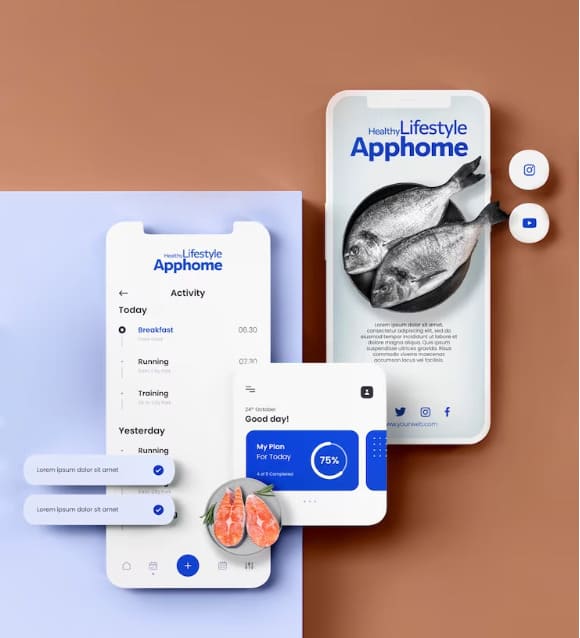The mobile app landscape in Asia Pacific is exploding with immense growth and opportunity. According to Statista, the number of mobile app downloads in the region will be 7 billion by 2030. With over 94% of smartphone users across diverse countries and cultures, building mobile app security and mobile app scalability is crucial for tapping into this expanding market.
This article will provide insights and best practices for leveraging new technologies to build secure, scalable mobile apps tailored for the evolving APAC market. We will explore strategies for areas like app architecture, data security, localization, and monetization.
Table of Contents
Overview of the APAC Mobile Market
Growth trends in mobile app development for APAC
The APAC region has seen explosive growth in mobile app usage in recent years. According to App Annie’s State of Mobile 2022 report, consumer spending on mobile apps and games in Asia will reach $270 billion by 2025, more than doubling from 2020 levels.
South Korea, China, and Japan have led the way as mobile markets, but other emerging countries like India, Indonesia, and Vietnam are also showing significant momentum. The rising middle class and improved access to high-speed internet across Asia have helped fuel this surge in mobile adoption and engagement.
Key countries/regions to focus on app service providing
Within the diverse APAC landscape, several locations stand out as high-priority markets for mobile app developers. As of 2024, China remains the world’s largest app market by revenue and number of downloads despite increased regulations; approximately 1.07 billion people actively use smartphones in China.
India’s growing young population and internet boom make it another indispensable region. In 2022, 759 million individuals used the Internet monthly in India, and this number is expected to reach 900 million by 2025.
Southeast Asian countries like Vietnam, Thailand, and Indonesia have also become invaluable for their rapidly expanding app user bases. When expanding regionally, focusing first on these strategic locations will allow companies to tap large audiences while gaining experience navigating the nuances of different APAC cultures and regulations.
Opportunities and Challenges in Mobile Apps Development in APAC
Opportunities
- Huge User Base: APAC has a massive population, with a significant portion having access to smartphones. This vast user base presents immense opportunities for developers to reach a large audience and gain traction for their mobile apps.
- Emerging Markets: APAC includes several emerging markets with growing economies, such as India, Indonesia, and Vietnam. These markets offer tremendous potential for mobile app developers, as smartphone adoption and internet penetration rates continue to rise.
- Localization: APAC is culturally diverse, with numerous languages, customs, and preferences. This presents an opportunity for developers to create localized mobile apps that cater to specific markets. By adapting the app’s language, content, and user experience to local preferences, developers can enhance user engagement and increase adoption.
- Mobile Payment Adoption: Mobile payments have gained significant traction in APAC, with countries like China and South Korea leading the way. This trend opens up opportunities for developers to integrate mobile payment systems, such as Alipay, WeChat Pay, and Paytm, into their apps, enabling seamless transactions and monetization.
- Mobile Gaming Market: APAC has a thriving mobile gaming market, with a large and enthusiastic gaming community. Developing mobile games or incorporating gamification elements into apps can be a lucrative opportunity, given the high demand for engaging and entertaining experiences.
Challenges
- Fragmented Market: APAC comprises a diverse range of countries, each with its unique language, culture, and regulatory environment. This fragmentation poses challenges in terms of localization, understanding local user preferences, complying with regulations, and navigating different app stores and distribution channels.
- Connectivity and Infrastructure: While APAC has seen significant improvements in internet connectivity, there are still variations in network speeds and infrastructure across the region. Developers must consider these differences when optimizing their apps for different markets, ensuring smooth performance even in areas with limited connectivity.
- App Monetization: Monetizing mobile apps in APAC can be challenging due to varying app purchasing behaviors, payment preferences, and willingness to pay. Developers need to carefully consider the most effective monetization models for each market, such as in-app purchases, ads, or subscription-based services.
- Localization and Cultural Sensitivity: APAC’s diverse cultures and languages require developers to invest in localization efforts. Adapting the app’s content, design, and user interface to align with local preferences and cultural sensitivities is crucial for successful user engagement.
- Competition: The APAC mobile app market is highly competitive, with a multitude of local and global players vying for users’ attention. Developers need to differentiate their apps by offering unique value propositions, superior user experiences, and effective marketing strategies to stand out in this crowded marketplace.
- Data Privacy and Security: Data privacy and security concerns are paramount in APAC, with various countries implementing stringent regulations. Developers must ensure compliance with local data protection laws, implement robust security measures, and prioritize user privacy to build trust and maintain user confidence. That’s why mobile app security in APAC is a vital point any app developer should consider.
The Importance of Building Secure and Scalable Mobile Apps
To effectively tap into the vast opportunities of the APAC mobile market, developers must build secure and scalable apps – which leads into our next section.
Mobile app security APAC best practices

Authentication in mobile apps
Strong user authentication is paramount in a region with diverse cyber threats and data privacy expectations across borders. To practice mobile app security APAC is to Implement OAuth or OpenID for social logins alongside password-based signups. Enable multi-factor authentication via SMS, authentication apps, or biometric IDs to minimize account takeovers.
Data encryption in mobile apps
Be diligent about encrypting all user data in transit and at rest. This includes personally identifiable information, financial details, location data, and other sensitive fields. Utilize SSL/TLS and HTTPS for network traffic and AES-256 or better for storage. Process payments and other transactions securely via tokenized solutions.
Endpoint protection in mobile apps
Mobile malware is growing exponentially, elevating the need for endpoint security. Configure apps to automatically update from official stores. Sandbox app environments and isolate permissions. Monitor devices for infection with antivirus solutions. Consider mobile threat defense for tailored protection across device ecosystems.
Secure coding practices in mobile apps
Hardening the code base is foundational for Mobile app security in APAC Enforce strict input validation, authenticate all API requests, guard against injection attacks, and sanitize all untrusted inputs. Conduct threat modeling and penetration testing. Require app developers to attend secure development training. Patch vulnerabilities quickly via automated processes upon code changes.
Practices Mobile App Scalability
Microservices in scalable mobile app
Breaking monolithic apps into independent microservices enhances scalability. Each microservice runs isolated processes focused on specific tasks. This allows scaling services independently based on demand spikes. It also facilitates agile deployment and experimentation. For example, keeping user profile data separate from friend networks or notification is a feature many developers from the region focus on when building mobile app scalability in APAC
Serverless computing in scalable mobile app
Leveraging serverless architectures relieves the need to manage servers. This shifts responsibility for capacity planning and auto-scaling to cloud providers. It empowers developers to focus solely on code and triggers. Functions as a Service (FaaS) platforms automatically spin up execution environments based on event loads. This elastic approach is well-suited for volatile traffic from viral apps or season spikes.
Cloud hosting for scalable mobile app
Public cloud platforms deliver scalable hosting with pay-as-you-go pricing. Horizontal scaling allows increasing compute units and database reads/writes on demand. Vertical scaling optimizes for performance and cost. Caching layer technologies aid scalability. Content Delivery Networks ensure fast delivery to users worldwide. Intelligent routing distributes traffic loads evenly across regions automatically. Monitoring dashboards provide full visibility into infrastructure resource usage.
Strategies for Building Secure and Scalable Mobile Apps

Diverse Technical Capabilities and Infrastructure in APAC
Address Variances in Privacy and Data Regulations
APAC comprises countries with varying privacy and data protection regulations. To build secure mobile apps, it is crucial to address these variances. Developers should thoroughly understand the specific regulations in each target market and ensure compliance with local laws. Implementing robust data encryption, secure authentication mechanisms, and privacy controls can help protect user data and maintain trust, therefore enhancing user experience in mobile apps.
Support Multiple Regulations in the APAC region
Given the diversity of privacy and data regulations in APAC, it is essential to support multiple regulatory frameworks within your mobile app. This includes providing options for users to customize privacy settings, consent management, and data sharing preferences. By offering flexibility and transparency, you can cater to the specific requirements of each market and enhance user trust.
Provide Multiple Languages
To cater to the linguistic diversity in APAC, consider providing support for multiple languages within your mobile app. This involves incorporating language localization features, such as translations for user interfaces, content, and in-app communications. By allowing users to engage with the app in their preferred language, you enhance user experience and facilitate broader adoption.
Provide Localized Support Options
Building a scalable mobile app in APAC requires offering localized support options. This includes providing customer support channels in local languages, establishing regional support teams, and offering culturally sensitive assistance. By addressing user queries, concerns, and feedback promptly and effectively, you can improve user satisfaction and retention.
Cater Payment Options to Local Systems
APAC encompasses various payment systems and preferences. To ensure smooth transactions and monetization, integrate payment options that align with local systems. This may involve supporting popular local payment gateways, mobile wallets, or digital payment platforms widely used in specific markets. By providing familiar and convenient payment options, you enhance user experience and increase conversion rates.
Infrastructure Considerations
APAC exhibits diverse levels of technological infrastructure and network connectivity. When building scalable mobile apps, consider the infrastructure limitations of target markets. Optimize app performance to accommodate varying network speeds and connectivity issues. Implementing data compression techniques, caching mechanisms, and offline capabilities can enhance user experience, particularly in areas with limited connectivity.
Cloud-Based Scalability
Leveraging cloud computing services can provide scalability and flexibility in APAC. By utilizing cloud platforms, you can easily scale up or down your app’s infrastructure based on demand. Cloud services also offer geographically distributed servers, reducing latency and improving app performance across the region.
Incorporating these strategies into your mobile app development process can help address the diverse technical capabilities and infrastructure challenges in APAC. By considering variances in privacy regulations, supporting multiple languages, providing localized support, catering to local payment systems, and optimizing for infrastructure limitations, you can build secure, scalable, and user-friendly mobile apps that resonate with APAC users.
Optimize UX for Varying Screen Sizes
As the availability of affordable large-screen devices increases across APAC, UI/UX should follow responsive design principles. Fluidly adapt layout, text size, and interactions based on a wide range of screen widths from smartwatches to tablets. The APAC market is home to a huge variety of mobile phones, with models ranging drastically in screen sizes.
Some regions primarily use devices with smaller screens, while others have widely adopted larger displays. Apps need to provide optimized experiences that work seamlessly across this diverse spectrum of screen sizes and formats that consumers utilize. Graceful scaling and formatting of content will help apps appeal to the full range of technical capabilities present in the APAC mobile market.

Ensure High Performance on Diverse Networks in APAC
Within the vast APAC region, infrastructure and network environments vary tremendously between countries based on their stage of development. From countries with advanced cellular technologies to ones still relying heavily on 2G connectivity, apps need to perform reliably across a wide spectrum of networks.
Carriers, protocols, and speeds fluctuate not just within individual countries, but also between the diverse nations across Asia. Optimize asset sizes, preload/cache resources, and implement techniques like code splitting for faster load times under these unpredictable network conditions that may include differing bandwidth, latency, and uptime depending on location. Conduct regional testing across the many network environments present to identify and address bottlenecks specific to certain territories. A resilient, well-optimized app experience is key to success within APAC’s heavily fragmented digital infrastructures.
Conclusion
In conclusion, the APAC region presents massive opportunities for growth but also complex challenges to building mobile app scalability and mobile app security in APAC that can succeed universally. Navigating its diversity requires a localized mindset and adaptive strategies across technical development, business operations, and regulatory compliance. Those who can effectively address the region’s fragmentation by regionalizing key experiences and optimizing for diverse conditions will be poised to tap its immense commercial potential.
While the task is demanding, gaining a foothold in even a few high-priority APAC markets can reap substantial rewards. Understanding that, VINOVA was established to be the leading mobile application development company focused on meeting the unique needs of Secure and Scalable Mobile Apps in APAC. Visit our website now for more information on our service!